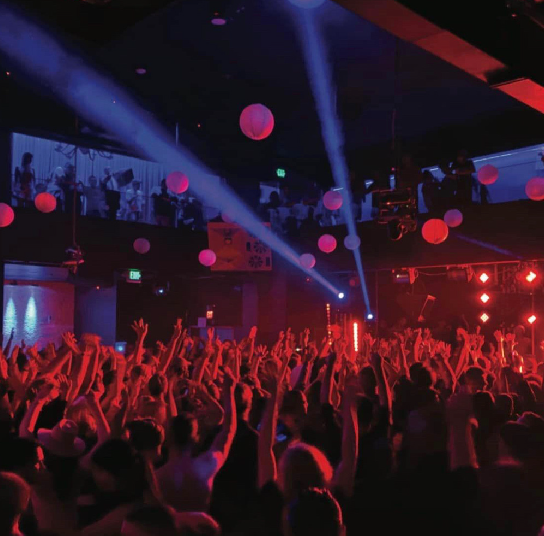Office Hours: Sociology Professor and Dance Music Culture Researcher Danielle Hidalgo

A self-professed “’90s rave kid,” sociology professor Danielle Hidalgo literally stumbled upon her next research project at a live dance music event in London in 2017. Unimpressed with the first floor of the club, she was about to leave when she heard that sound that was all too familiar during her early rave days, a sound that always made her dance. She chased it down a few flights of stairs until she arrived at a dance floor with “We Still Believe” shining from a neon sign above the DJ booth.
“I proceeded to dance my butt off for the first time since the 90s,” she said.
The experience set her on a trajectory. For the next four years, she would physically and digitally follow three women DJs in an immersive research experience, asking questions about what had changed since her early rave days. How were clubs, clubbers, and DJs navigating this new terrain? Her new book, Dance Music Spaces: Clubs, Clubbers, and DJs Navigating Authenticity, Branding, and Commercialism, tells this story.
Here, she joins us to answer questions about her book.
Your research was rooted in “spatiotemporal embodied relations.” What does that mean and why did you think that was the best approach to studying clubbing?
So much about entering into and being in a club is the physical experience. It’s amazing to me that so many dance music studies haven’t done a good job of really bringing us into these spaces. Why are embodied experiences so often missing from the actual literature? Why aren’t we moving through these spaces with the author? I conducted intensive fieldwork over the New Year’s Eve dance music season, following The Blessed Madonna (TBM), Honey Dijon, Peggy Gou, and their colleagues, and attending venues from London to Glasgow, Amsterdam to Berlin, and San Francisco to New York. The New Year’s Eve season is a busy and important time of the year in the dance scene, one that includes back-to-back events over a three-to-five-day period. I didn’t want to just do interviews, so instead, you come into the space with me and you get a sense of the social and cultural patterns of these spaces by paying attention to how people navigate the dance floors and surrounding areas. And I wanted to encourage other researchers to do that kind of embodiment work—mapping and analyzing embodied experiences in time and physical space.
Hidalgo Fact #1
During the 2017–18 New Year’s Eve tour season, Hidalgo got a glimpse of the DJs’ demanding tour schedule as she only managed to get a couple hours of sleep in four days in a whirlwind European tour, attending multiple events a day.
Why did you choose to follow three women DJs?
I don’t know of any other study quite like mine. There are a few books on women DJs, but of all the work on DJs, a lot of it is on men. All three of the DJs I studied (TBM, Honey Dijon, and Peggy Gou) have been disrupting dance music—the music, the culture, the spaces—and they have been vocal about messing with the status quo. There are so few women, especially in positions of power. I wanted to get a better sense of what successful women DJs—like TBM, Dijon, and Gou—are up against. Plus, as I describe in the book, their digital practices—activity on Instagram, for example—reveal so much about the careful curation that they have to do as women DJs/producers in dance music today, practices that revealed a process I describe as authenticity maneuvering. These DJs and their colleagues are constantly engaging in authenticity work to gain and maintain legitimacy and a lot of this authenticity work is happening online.
Hidalgo Fact #2
Her favorite DJs are those who “get me to move on the dance floor.” She especially loves DJ Dan and Mark Farina—DJs who always bring her back to the 90s—and some new favorite DJs are Jayda G, Nala, HAAi, Octo Octa, and Eris Drew.
Why is the rave ethos of peace, love, unity, and respect (PLUR) so integral to the dance scene—and has its prevalence changed?
The history of house music came out of marginalized spaces and communities, and PLUR came out of that. The way people talk about it is respect for others, communality, not discriminating, loving others, and coming together as a community. While the PLUR acronym isn’t really used today and many clubbers haven’t even heard of it, the values attached to it are often utilized. So, I was interested in better understanding how these values are referenced, utilized, and, in some cases, institutionalized. For example, at one club in Amsterdam, they post a sign about what they expect clubbers to be doing and they talk about not being individualistic as you navigate the space. When you want to have a pleasurable time, take responsibility for the pleasure of others too. So, I was interested in how a rave ethos was utilized by clubs, clubbers, and DJs and what its utilization actually accomplished.
What social and cultural contradictions did you see emerging in contemporary dance music spaces?
There is still so much to discover about what dance music culture is going to look like coming out of this pandemic. The best way to describe it now is we have these tensions. While a rave ethos is present, there is also so much commercialism now—and it’s often happening at the same time. That became my story. As an example, at a New Year’s Eve event with TBM as the headliner, strangers were coming together and embracing during the countdown. Five minutes later, as TBM left the stage and less famous DJs took her place, the entire front of the dance floor started clearing out. Everyone had been coming together, showing love for one another and the scene, and the next minute, they are disrespecting the DJs. It challenges the values and the practice of a rave ethos, and it can create this weird tension and discomfort, especially for folks like me who were there in those early rave days.
Hidalgo Fact #3
To continue studying the scene’s evolution, she plans to check out a number of clubs that now have policies limiting the use of smartphones, another example of the institutionalization of a rave ethos.
What needs to change for dance music to return to a rave ethos that doesn’t position money-making above everything else?

I think we need to be really clear about what this ethos looks like and how it’s realized—for clubs, clubbers, and DJs. Going forward, it’s got to be a collective shift and conversation. I end the book with some reflections on what it doesn’t look like: standardization, uniformity, and predictability; an emphasis on quantity over quality; the commodification of everything from DJs to their music is expected and supported; lineups that are primarily made up of cisgender white men; etc. Coming out of this pandemic, folks in dance music are talking about and making moves that directly challenge these patterns going forward. While I’m hopeful, it remains to be seen how much will actually change and these are some questions I’m asking as I start the next phase of my research.
Hidalgo has taught in the Sociology Department since 2015 and focuses on classical and contemporary theory and courses related to gender, sex, and sexuality. She completed her master’s in sociology at the London School of Economics and Political Science (LSE) and her PhD at the University of California, Santa Barbara. Before Hurricane Katrina, she also completed graduate work at Tulane University in New Orleans, an experience that resulted in a co-edited book on the storm’s sociological impact, Narrating the Storm: Sociological Stories of Hurricane Katrina.


